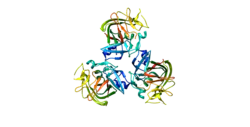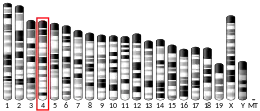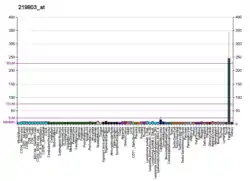Angiopoietin-like 3, also known as ANGPTL3, is a protein that in humans is encoded by the ANGPTL3 gene.[5][6]
Function
The protein encoded by this gene is a member of the angiopoietin-like family of secreted factors. It is expressed predominantly in the liver, and has the characteristic structure of angiopoietins, consisting of a signal peptide, N-terminal coiled-coil domain, and the C-terminal fibrinogen (FBN)-like domain. The FBN-like domain in angiopoietin-like 3 protein was shown to bind alpha-5/beta-3 integrins, and this binding induced endothelial cell adhesion and migration. This protein may also play a role in the regulation of angiogenesis.[5]
Angptl3 also acts as dual inhibitor of lipoprotein lipase (LPL) and endothelial lipase (EL),[7] thereby increasing plasma triglyceride, LDL cholesterol and HDL cholesterol in mice and humans.[7]
ANGPTL3 inhibits endothelial lipase hydrolysis of HDL-phospholipid (PL), thereby increasing HDL-PL levels. Circulating PL-rich HDL particles have high cholesterol efflux abilities.
Angptl3 plays a major role in promoting uptake of circulating triglycerides into white adipose tissue in the fed state,[8] likely through activation by Angptl8, a feeding-induced hepatokine,[9][10] to inhibit postprandial LPL activity in cardiac and skeletal muscles,[11] as suggested by the ANGPTL3-4-8 model.[12]
Clinical significance
In human, ANGPTL3 is a determinant factor of HDL level and positively correlates with plasma HDL cholesterol.
In humans with genetic loss-of-function variants in one copy of ANGPTL3, the serum LDL-C levels are reduced. In those with loss-of-function variants in both copies of ANGPTL3, low LDL-C, low HDL-C, and low triglycerides are seen ("familial combined hypolipidemia").[13]
References
- 1 2 3 GRCh38: Ensembl release 89: ENSG00000132855 - Ensembl, May 2017
- 1 2 3 GRCm38: Ensembl release 89: ENSMUSG00000028553 - Ensembl, May 2017
- ↑ "Human PubMed Reference:". National Center for Biotechnology Information, U.S. National Library of Medicine.
- ↑ "Mouse PubMed Reference:". National Center for Biotechnology Information, U.S. National Library of Medicine.
- 1 2 "Entrez Gene: ANGPTL3 angiopoietin-like 3".
- ↑ Conklin D, Gilbertson D, Taft DW, Maurer MF, Whitmore TE, Smith DL, et al. (December 1999). "Identification of a mammalian angiopoietin-related protein expressed specifically in liver". Genomics. 62 (3): 477–82. doi:10.1006/geno.1999.6041. PMID 10644446. S2CID 16567474.
- 1 2 Tikka A, Jauhiainen M (May 2016). "The role of ANGPTL3 in controlling lipoprotein metabolism". Endocrine. 52 (2): 187–93. doi:10.1007/s12020-015-0838-9. PMC 4824806. PMID 26754661.
- ↑ Wang Y, McNutt MC, Banfi S, Levin MG, Holland WL, Gusarova V, et al. (September 2015). "Hepatic ANGPTL3 regulates adipose tissue energy homeostasis". Proceedings of the National Academy of Sciences of the United States of America. 112 (37): 11630–5. Bibcode:2015PNAS..11211630W. doi:10.1073/pnas.1515374112. PMC 4577179. PMID 26305978.
- ↑ Zhang R (August 2012). "Lipasin, a novel nutritionally-regulated liver-enriched factor that regulates serum triglyceride levels". Biochemical and Biophysical Research Communications. 424 (4): 786–92. doi:10.1016/j.bbrc.2012.07.038. PMID 22809513.
- ↑ Ren G, Kim JY, Smas CM (August 2012). "Identification of RIFL, a novel adipocyte-enriched insulin target gene with a role in lipid metabolism". American Journal of Physiology. Endocrinology and Metabolism. 303 (3): E334-51. doi:10.1152/ajpendo.00084.2012. PMC 3423120. PMID 22569073.
- ↑ Fu Z, Abou-Samra AB, Zhang R (December 2015). "A lipasin/Angptl8 monoclonal antibody lowers mouse serum triglycerides involving increased postprandial activity of the cardiac lipoprotein lipase". Scientific Reports. 5: 18502. Bibcode:2015NatSR...518502F. doi:10.1038/srep18502. PMC 4685196. PMID 26687026.
- ↑ Zhang R (April 2016). "The ANGPTL3-4-8 model, a molecular mechanism for triglyceride trafficking". Open Biology. 6 (4): 150272. doi:10.1098/rsob.150272. PMC 4852456. PMID 27053679. Archived from the original on 2018-08-04. Retrieved 2016-04-15.
- ↑ Musunuru K, Pirruccello JP, Do R, Peloso GM, Guiducci C, Sougnez C, et al. (December 2010). "Exome sequencing, ANGPTL3 mutations, and familial combined hypolipidemia". The New England Journal of Medicine. 363 (23): 2220–7. doi:10.1056/NEJMoa1002926. PMC 3008575. PMID 20942659.
Further reading
- Miida T, Seino U, Miyazaki O, Hanyu O, Hirayama S, Saito T, et al. (October 2008). "Probucol markedly reduces HDL phospholipids and elevated prebeta1-HDL without delayed conversion into alpha-migrating HDL: putative role of angiopoietin-like protein 3 in probucol-induced HDL remodeling". Atherosclerosis. 200 (2): 329–35. doi:10.1016/j.atherosclerosis.2007.12.031. PMID 18279878.
- Moon HD, Nakajima K, Kamiyama K, Takanashi K, Sakurabayashi I, Nagamine T (December 2008). "Higher frequency of abnormal serum angiopoietin-like protein 3 than abnormal cholesteryl ester transfer protein in Japanese hyperalphalipoproteinemic subjects". Clinica Chimica Acta; International Journal of Clinical Chemistry. 398 (1–2): 99–104. doi:10.1016/j.cca.2008.08.021. PMID 18804459.
- Li C (April 2006). "Genetics and regulation of angiopoietin-like proteins 3 and 4". Current Opinion in Lipidology. 17 (2): 152–6. doi:10.1097/01.mol.0000217896.67444.05. PMID 16531751. S2CID 37001655.
- Camenisch G, Pisabarro MT, Sherman D, Kowalski J, Nagel M, Hass P, et al. (May 2002). "ANGPTL3 stimulates endothelial cell adhesion and migration via integrin alpha vbeta 3 and induces blood vessel formation in vivo". The Journal of Biological Chemistry. 277 (19): 17281–90. doi:10.1074/jbc.M109768200. PMID 11877390.
- Kaplan R, Zhang T, Hernandez M, Gan FX, Wright SD, Waters MG, Cai TQ (January 2003). "Regulation of the angiopoietin-like protein 3 gene by LXR". Journal of Lipid Research. 44 (1): 136–43. doi:10.1194/jlr.M200367-JLR200. PMID 12518032.
- Shimamura M, Matsuda M, Kobayashi S, Ando Y, Ono M, Koishi R, et al. (February 2003). "Angiopoietin-like protein 3, a hepatic secretory factor, activates lipolysis in adipocytes". Biochemical and Biophysical Research Communications. 301 (2): 604–9. doi:10.1016/S0006-291X(02)03058-9. PMID 12565906.
- Zeng L, Dai J, Ying K, Zhao E, Jin W, Ye Y, et al. (2003). "Identification of a novel human angiopoietin-like gene expressed mainly in heart". Journal of Human Genetics. 48 (3): 159–62. doi:10.1007/s100380300025. PMID 12624729.
- Ono M, Shimizugawa T, Shimamura M, Yoshida K, Noji-Sakikawa C, Ando Y, et al. (October 2003). "Protein region important for regulation of lipid metabolism in angiopoietin-like 3 (ANGPTL3): ANGPTL3 is cleaved and activated in vivo". The Journal of Biological Chemistry. 278 (43): 41804–9. doi:10.1074/jbc.M302861200. PMID 12909640.
- Zhang Z, Henzel WJ (October 2004). "Signal peptide prediction based on analysis of experimentally verified cleavage sites". Protein Science. 13 (10): 2819–24. doi:10.1110/ps.04682504. PMC 2286551. PMID 15340161.
- Liu T, Qian WJ, Gritsenko MA, Camp DG, Monroe ME, Moore RJ, Smith RD (2006). "Human plasma N-glycoproteome analysis by immunoaffinity subtraction, hydrazide chemistry, and mass spectrometry". Journal of Proteome Research. 4 (6): 2070–80. doi:10.1021/pr0502065. PMC 1850943. PMID 16335952.
- Shimamura M, Matsuda M, Yasumo H, Okazaki M, Fujimoto K, Kono K, et al. (February 2007). "Angiopoietin-like protein3 regulates plasma HDL cholesterol through suppression of endothelial lipase". Arteriosclerosis, Thrombosis, and Vascular Biology. 27 (2): 366–72. doi:10.1161/01.ATV.0000252827.51626.89. PMID 17110602.





